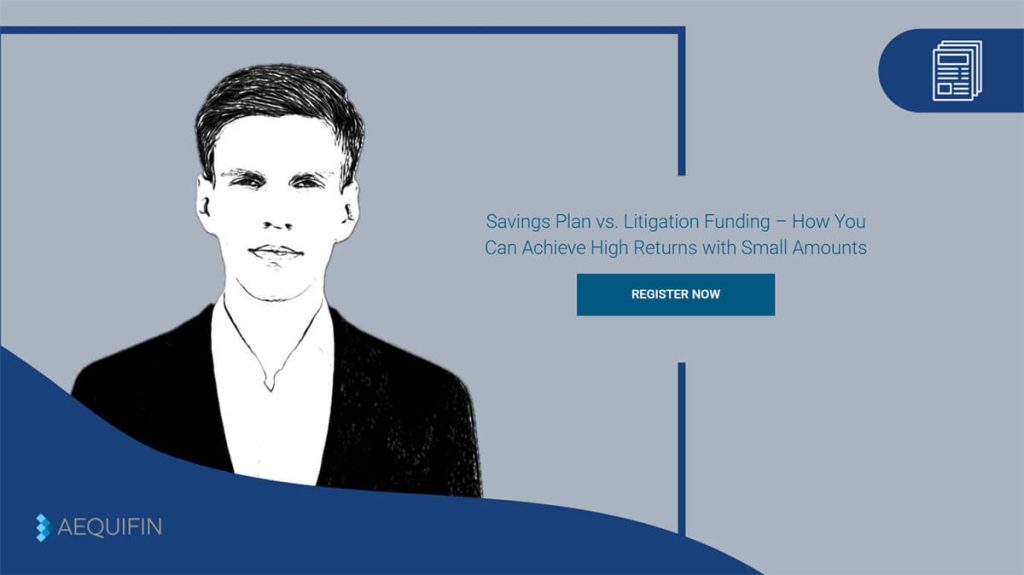The interest rate turnaround has awakened savers, yet the hoped-for renaissance of the savings account has failed to materialize. While banks advertise minimal deposit interest, inflation continues to erode real returns. So where can returns still be achieved today without taking on speculative risks?
At the same time, the market for alternative investments is booming. Platforms for P2P lending, crowd investing, and photovoltaic investments are seeing record inflows. The desire for passive income is no longer a niche topic—it has become a guiding principle of modern personal wealth planning.
Can you make money from legal cases? This question may sound unusual at first but is highly relevant. In litigation funding, investors indirectly participate in legal proceedings. Together with other sponsors of a lawsuit, they cover the costs of the case and receive a share of the awarded amount if the case is successful.
What was once considered a niche product for specialized investors is increasingly becoming an alternative to savings accounts or traditional investments. For private investors, this opens up an investment form that promises high returns while remaining independent of the ups and downs of capital markets.
1. What Counts as Passive Income?
The term “passive income” is unfortunately used far too loosely these days. At its core, it describes regular income that is not earned through active work but through prior investments or automated processes.
Classic examples include rental income, dividend payments, or interest from bonds. Digital models such as licensing fees or affiliate earnings also fall into this category. The key factor is that the flow of capital, after the initial investment, remains largely independent of time or labor input.
In the financial world, passive income is seen as a cornerstone of financial freedom. It allows investors to grow their capital continuously without having to make daily decisions. However, while the concept sounds deceptively simple, the challenge lies in execution. High returns rarely come without risk, and stable earnings usually require a diversified portfolio.
What Types of Passive Income Exist?
The possibilities for generating passive income are diverse and ranging from conservative savings plans to alternative investments with higher risk–return profiles. While savings plans and funds remain heavily dependent on market conditions, alternative investments such as litigation funding offer a new type of income source. One that does not fluctuate with economic cycles but is instead based on the real outcomes of legal proceedings.
Table
2. How Can You Best Earn Passive Income?
The desire for a steady income stream without daily market monitoring is increasingly shaping private investors’ strategies. Yet the question of which model truly generates reliable passive income remains complex. At its core, five main approaches have emerged, each differing significantly in terms of risk, return, and effort:
- Savings Plans (Funds & ETFs)
- Stable and predictable, ideal for long-term wealth building
- Average return: 4–8% p.a.
- Disadvantage: highly dependent on market cycles and geopolitical developments
- P2P Loans
- Investors lend money to individuals or companies
- High interest rates between 7–12%, but risk of default during economic downturns
- Requires more oversight, limited liquidity
- Crowdinvesting
- Participation in real estate or business projects
- Attractive returns, often 6–10%, depending on project success
- Risk: potential project defaults and long investment periods
- Photovoltaic Investments
- Sustainable alternative with 5–8% returns
- Technical risk (maintenance, sunlight exposure)
- Higher initial capital required
- Litigation Funding
- Investors finance legal cases and, in the event of success, share in the awarded proceeds
- Independent of stock markets and interest rates, investment possible within minutes
- Return potential up to 10x the invested capital, depending on case outcome
3. How Much Money Do You Need for Passive Income?
The amount of capital required for passive income depends on the chosen strategy and the expected return. The following example illustrates the range:
- At an annual return of 3%, you would need to invest around €400,000 to generate a monthly income of €1,000.
- At 6% return, the required capital drops to about €200,000.
- At 10% return, a capital of €120,000 would already be sufficient.
What do these figures show? Traditional investments such as savings accounts or fixed deposits are hardly suitable for generating meaningful additional income. Investors with smaller amounts therefore look for models that offer lower entry thresholds without sacrificing return potential.
How Much Passive Income Do You Need to Stop Working?
This question is less financial than psychological. Statistics show that those who can cover 70–80% of their previous net income through passive sources achieve a significant level of financial independence.
However, the goal is rarely complete freedom from work but rather predictability. Passive income acts as a stabilizer, balancing market fluctuations, creating liquidity, and opening up new investment opportunities. The more volatile the capital markets become in the current interest rate environment, the more valuable uncorrelated sources of return are and it is precisely this independence that litigation funding offers
IN JUST 5 MINUTES:
4. How Does Passive Income Through Litigation Funding Work in Practice?
An external financier — such as a specialized platform like AEQUIFIN — covers the costs of a legal proceeding. These include attorney fees, court fees, and expert expenses.
If the case is successful, the financier receives a percentage share of the awarded amount. If the case fails, the financier bears all the costs alone.
- No direct litigation risks – losses are limited to the invested capital
- High return potential – success shares often range between 200% and 1,000% per case
- Independence from markets – returns depend solely on the legal outcome, not on stock markets or interest rates
How the Model Works for Private Investors
Until a few years ago, litigation funding was reserved exclusively for institutional investors. Today, platforms like AEQUIFIN are opening the market to private investors.
The process follows clear steps:
- Case Evaluation – Lawyers and analysts assess the chances of success, the amount in dispute, and the creditworthiness of the opposing party.
- Financing Decision – Only vetted cases with strong prospects of success are listed on the platform.
- Investment Phase – Investors can participate with small amounts, starting from €500 to €1,000.
- Litigation Phase – During the legal process, the invested capital remains tied up.
- Success Scenario – In the event of a favorable judgment or settlement, the agreed profit share is paid out, usually after several months.
The result is an investment form with manageable capital requirements but above-average return potential and through that completely detached from market fluctuations, monetary policy, or inflation.
What Are the Advantages and Disadvantages of Litigation Funding at a Glance?
As with any investment, return and risk are two sides of the same coin. However, the risk structure here differs significantly from traditional investments.
Advantages of Litigation Funding
- No correlation with stock or real estate markets
- Clear success prospects through legal pre-assessment
- Social value – investors help finance justice
- Transparent platform processes with documented cases
Risks of Litigation Funding
- Dependent on the success of the case – no guaranteed return
- Longer capital commitment until the case is concluded
- Lower liquidity, as no secondary market exists
5. Conclusion
Litigation funding is no longer a niche or exotic topic. What was once reserved for specialized funds is now accessible to private investors thanks to digital platforms. It exemplifies a shift in investment thinking.
Away from interest rates and market prices, toward uncorrelated sources of return based on real-world outcomes. In today’s environment, litigation funding can be a valuable addition to a portfolio, an alternative to savings accounts, with a clear risk-return profile and measurable social impact.














